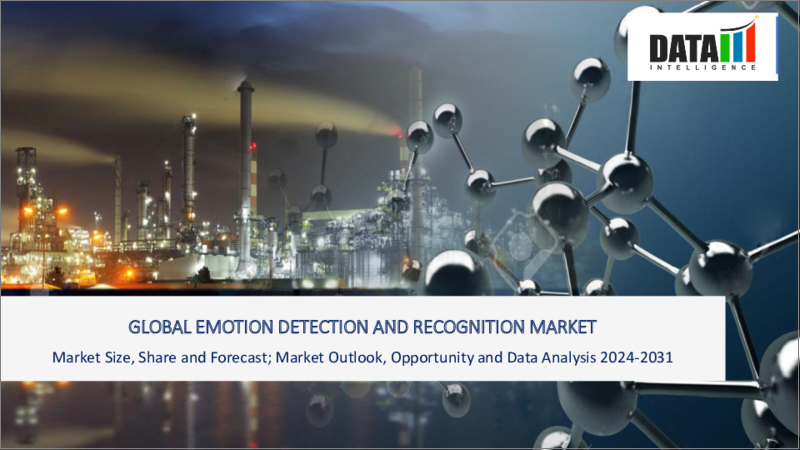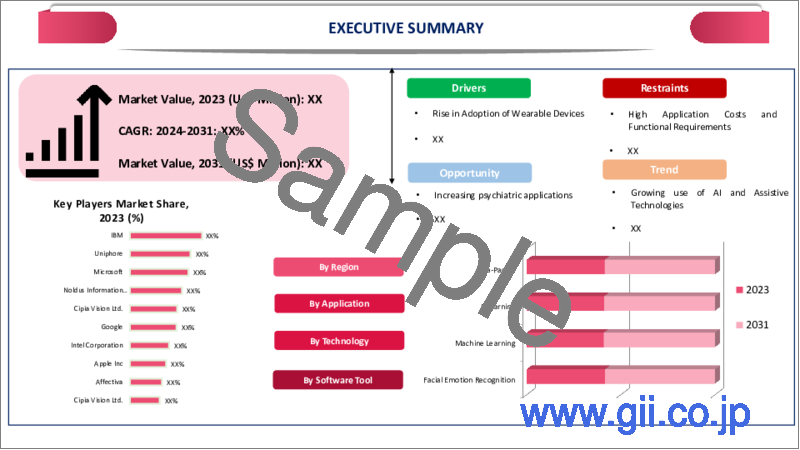|
|
市場調査レポート
商品コード
1374874
感情検出・認識の世界市場-2023年~2030年Global Emotion Detection And Recognition Market - 2023-2030 |
||||||
カスタマイズ可能
適宜更新あり
|
|||||||
| 感情検出・認識の世界市場-2023年~2030年 |
|
出版日: 2023年11月01日
発行: DataM Intelligence
ページ情報: 英文 201 Pages
納期: 即日から翌営業日
|
- 全表示
- 概要
- 目次
概要
世界の感情検出・認識市場は、2022年に222億米ドルに達し、2023-2030年の予測期間中にCAGR 11.4%で成長し、2030年には444億米ドルに達すると予測されています。
世界の感情検出・認識市場を牽引しているのは、健康、マーケティング、小売、セキュリティ分野など様々な分野での需要の増加です。感情検出には、データを分析して感情を解釈するために使用される様々な方法があります。画像処理と感情検出には、主にコンピュータ・ビジョンのアルゴリズムが使用されます。
感情検出・認識(EDR)の需要は、AIとMLの利用拡大が主な要因となっています。EDRモデルは、音声、生理学的信号、表情を含むさまざまなデータ・ソースから感情を識別・特定するために、AIやMLアルゴリズムを使って訓練されます。AIとMLの機能を備えたEDRシステムは、従来のEDRシステムよりも精度が高いです。
これは、AIやMLアルゴリズムが、人間には見えにくいデータ内の複雑なパターンを認識する能力を持っているためです。AIやMLの技術が進歩すればするほど、AIやMLを搭載したEDRソリューションは安価になります。その結果、より幅広い組織や企業が利用できるようになっています。
アジア太平洋地域は、感情検出・認識市場において最も急成長している地域であり、市場全体の2/5近くを占めています。世界最大かつ最も急速に拡大している医療市場の1つがアジア太平洋にあります。医療分野では、EDR技術を利用して患者のケアと成果を高めています。
例えば、EDRシステムは患者の感情を追跡・識別するために使用されることがあり、これにより医療専門家は患者の要求をよりよく理解し、より個別化された治療を提供することができます。この地域の様々な研究者が先進技術の開発に投資しており、市場にチャンスをもたらしています。
ダイナミクス
感情検出・認識に広く使用されるセンサー
顔の表情やボディランゲージは、カメラなどの視覚センサーを使って記録されます。感情を識別するための最も重要な指標の一つは表情であり、喜び、悲しみ、怒り、恐怖など様々な感情を伝えることができます。アイコンタクト、姿勢、ジェスチャーは、感情状態に関する重要な詳細を提供できるボディランゲージの一例です。
音声やその他の発声は、マイクなどの音声センサーによって記録されます。音声は、恐怖、怒り、悲しみ、楽しさなどの感情を識別するのに有効なツールです。笑いや涙は、感情状態に関する情報を提供する可能性のある発声の一例です。
感情を検出・識別する技術には、多くの可能性があります。新しい治療法の開発、マーケティング活動の調整、顧客サービスの向上などに応用できるかもしれないです。さらに、まったく新しい教育や娯楽体験を提供するために利用されるかもしれないです。心臓の電気的活動をモニターする非侵襲的検査の例として、心電図があります。心電図は、さまざまな心臓疾患の診断やモニタリングに用いられています。
マーケティング・広告における需要増大
感情検出・認識市場における技術の進歩は、消費者の感情に関する貴重な洞察を企業に提供します。エンターテイメント分野では、これらの技術は企業が顧客の嗜好を理解するのに役立っています。このため、こうした技術の採用需要が高まっています。消費者から情報を得るのに役立ち、それは後に市場成長に利用されます。
オンライン・プラットフォームは、自社製品の市場バスケット分析を利用しています。消費者の検索パターンを判断するのです。このアルゴリズムの助けを借りて、企業やブランドは特定のドメインの特定のオーディエンスをターゲットにします。アソシエーション・ルールを適用することで、彼らは商品とその購入者を関連付ける。消費者の心の状態を特定することで、マーケティング担当者はそのオーディエンスをターゲットにします。
プライバシーとセキュリティへの懸念
個人の画像をキャプチャする感情検出・認識は、プライバシーの懸念につながります。この技術は、表情や生理的プロセスなど、個人的でセンシティブなデータを分析します。ハッキングが増加するにつれ、人々はあらゆるAIツールと個人データを共有することに不安を感じるようになります。
ユーザーの受容と信頼もまた、感情検出・認識システムの需要が減少する主な要因です。企業はユーザーデータに対してより慎重になる必要があります。感情検出アプリケーションを他のテクノロジーに統合するのは複雑な作業です。他のソフトウェアとの互換性に問題があるからです。
目次
第1章 調査手法と調査範囲
第2章 定義と概要
第3章 エグゼクティブサマリー
第4章 市場力学
- 影響要因
- 促進要因
- 感情検出・認識に広く使用されるセンサー
- マーケティング・広告における需要増大
- 抑制要因
- 感情検出・認識市場におけるプライバシーとユーザーの受容
- 機会
- 影響分析
- 促進要因
第5章 産業分析
- ポーターのファイブフォース分析
- サプライチェーン分析
- 価格分析
- 規制分析
- ロシア・ウクライナ戦争の影響分析
- DMIの見解
第6章 COVID-19分析
第7章 テクノロジー別
- 機械学習
- 自然言語処理
- パターン認識ネットワーク
- その他
第8章 アプリケーション別
- 顔認識
- 音声・言語認識
第9章 エンドユーザー別
- 政府機関
- 医療機関
- 小売業
- アモルファスシリコン
第10章 地域別
- 北米
- 米国
- カナダ
- メキシコ
- 欧州
- ドイツ
- 英国
- フランス
- イタリア
- スペイン
- その他欧州
- 南米
- ブラジル
- アルゼンチン
- その他南米
- アジア太平洋
- 中国
- インド
- 日本
- オーストラリア
- その他アジア太平洋
- 中東・アフリカ
第11章 競合情勢
- 競合シナリオ
- 市況/シェア分析
- M&A分析
第12章 企業プロファイル
- Kairos AR,Inc.
- 会社概要
- 製品ポートフォリオと説明
- 財務概要
- 主な動向
- iMotions A/S
- Nodules Information Technology BV
- Amazon.com,Inc
- Realeyes
- IBM Corporation
- Google LLC
- Koppers Inc.
- Noldus Information Technology BV
- Entropik Technologies Pvt. Ltd.
第13章 付録
Overview
The Global Emotion Detection And Recognition market reached US$ 22.2 billion in 2022 and is expected to reach US$ 44.4 billion by 2030 growing with a CAGR of 11.4% during the forecast period 2023-2030.
The global emotion detection and recognition market is driven due to increases in demand for various sectors such as the health, marketing, retail and security sectors. Emotions detection has various methods used to analyze the data and interpret emotions. Computer vision algorithms are majorly used for image processing and emotion detection.
The demand for emotion detection and recognition (EDR) is mostly driven by the growing use of AI and ML. EDR models are trained using AI and ML algorithms to identify and identify emotions from a range of data sources, including speech, physiological signals and facial expressions. EDR systems with AI and ML capabilities are more precise than conventional EDR systems.
It is due to the fact that AI and ML algorithms have the ability to recognize intricate patterns in data that are hard for people to see. The more advanced AI and ML technologies get, the less expensive AI and ML-powered EDR solutions get. It are now more reachable by a wider range of organizations and businesses as a result.
Asia-Pacific is the fastest-growing region in the emotion detection and recognition market covering nearly 2/5th of the total market. One of the largest and most rapidly expanding healthcare marketplaces in the world can be found in Asia-Pacific. The healthcare sector is using EDR technologies to enhance patient care and results.
EDR systems, for instance, may be used to track and identify patients' emotions, which enables medical professionals to better understand their patients' requirements and deliver more individualized treatment. Various researchers in the region are investing in developing advanced technology leading to creating opportunities for the market.
Dynamics
Sensors Widely Used in Emotion Detection and Recognition
Facial expressions and body language are recorded using visual sensors, including cameras. One of the most crucial indicators for identifying emotions is facial expressions, which can convey a variety of feelings including joy, sorrow, rage and fear. Eye contact, posture and gestures are examples of body language that can provide important details about emotional state.
Speech and other vocalizations are recorded by audio sensors, including microphones. Speech is a useful tool for identifying emotions including fear, rage, sadness and enjoyment. Laughter and tears are examples of vocalizations that might provide information about one's emotional condition.
Technologies for detecting and identifying emotions have many possible uses. It may be applied to create novel medical treatments, tailor marketing efforts and enhance customer service. Additionally, it may be utilized to provide brand-new instructional and entertaining experiences. An example of a noninvasive test that monitors the electrical activity of the heart is the Electrocardiogram (EKG). It is employed in the diagnosis and monitoring for various cardiac diseases.
Rising Demand in Marketing and Advertising
The advancement in technology in the emotion detection and recognition market in which it provides valuable insights to companies about consumer emotions. In the entertainment sector, these technologies help companies to understand customer preferences. Due to this, the demand for adoption of these technologies increases. It helps to gain information from consumers which is later used for market growth.
Online platforms use market-basket analysis on their product. In which they determine the search pattern of the consumer. With the help of this algorithm companies or brands target a particular audience in a specific domain. By applying the association rule they relate the product and its buyer. By identifying the consumer's state of mind marketer targets their audience.
Privacy and Security Concerns
Emotion detection and recognition which capture images of individual persons lead to privacy concerns. It technology analyzes personal and sensitive data such as expressions and physiological processes. It raises concerns about the security of breaches of data and privacy, as hacking increases people are worried about sharing their personal data with any AI tools.
User acceptance and trust is also a major factor due to which demand for emotion detection and recognition system decreases. Companies need to be more cautious about user data. Integrating emotion detection applications into other technology is a complex task. As there will be compatibility issues with other software.
Segment Analysis
The global emotion detection and recognition are segmented based on technology, application, end-user and region.
Technological Advancements In Facial Recognition
With the rapid growth of facial recognition, it has been used in many industries. It works on facial segmentation of images which detects the emotions of any individual. There are various AI detection models that detect emotions. The emotions detection system works on many different parameters such as eye activity, motion analysis and skin resistance measurements. The technology has gained immense popularity in developed countries like U.S. and Canada due to the rising adoption of advanced technology thus covering more than 34.9% in the region.
The detection of emotion depends upon the local features of the face. For example, if the emotion detection tools detect the person's emotions such as anger or sadness, these factors can lead to detecting physiological responses such as there might be increased heart rate or any other issues. Emotional intelligence plays a major role in the detection and recognition of the decision-making process for individuals.
Companies have invested heavily in the market leading to a boost the segmental revenue. For instance, in October 2019, Fujitsu Laboratories, Ltd. and Fujitsu Laboratories of America, Inc. has announced the development of artificial intelligence (AI) face expression recognition technology that accurately recognizes small changes in facial expression. The new technique was created in partnership with the School of Computer Science at Carnegie Mellon University.
Geographical Penetration
North America: Leading the Growth of Emotion Detection And Recognition Market
In North America, AI and ML technologies are becoming more and more popular, especially in the EDR market. It is a result of the region's expanding computing power and data availability. North American governments are encouraging the development and implementation of EDR technology increasingly. It is a result of governments realizing how EDR technology may boost the efficacy and efficiency of public services. Because multimodal EDR systems are more accurate and less expensive than traditional EDR solutions, they are growing in popularity in North America.
EDR is being utilized in the healthcare sector to identify and track individuals who suffer from anxiety and depression. Additionally, EDR can assist patients in regulating their stress and provide better pain management. EDR is used in education to determine whether students are struggling and to evaluate student participation. EDR can be employed to the development of customized educational initiatives. EDR is being employed in the workplace to raise productivity and employee happiness. Workplace violence may also be identified and prevented with the use of EDR. Future EDR applications will likely offer up even more ground-breaking and innovative concepts as the technology develops.
Competitive Landscape
The major global players in the market include: Kairos AR, Inc., iMotions A/S, Noldus Information Technology BV, Amazon.com, Inc., Realeyes, IBM Corporation, Google LLC, Emotibot Technologies Limited, NuraLogix Corporation, Entropik Technologies Pvt . Ltd.
COVID-19 Impact Analysis
Globally, the pandemic has had a major negative influence on mental health, leading to higher levels of emotional discomfort, worry and stress. Technologies that detect emotions have been used to track and evaluate mental health issues. The significance of these tools in remotely monitoring and treating mental health concerns has been further highlighted by the pandemic
Systems for identifying and monitoring emotions that heavily rely on facial expressions have faced challenges as a result of the COVID-19 pandemic. Due to this masks are frequently used during social interactions as a precaution against the spread of the illness. So was challenging to recognize faces since the mask was leading to a loss of information.
Russia-Ukraine Conflict Analysis
In both accuracy and conclusions, emotion recognition algorithms often need a lot of different types of training data. The Ukraine conflict might restrict information-gathering efforts and have a consequence on the quantity and variety of data used to train emotion recognition algorithms. The growth of emotion detection technology in the area may be limited if data collection attempts are affected by the war.
The regional market dynamics, particularly the market for emotion detection, may be affected by the war. The demand as well as the growth in emotion detection technology in the affected regions, notably Russia and Ukraine, may be impacted by instability, economic difficulties and political uncertainty related to the conflict. Modifications in market growth and investment may result from this.
AI Analysis
AI-powered emotion detection systems may be trained on a variety of datasets, which enables them to fully understand and identify emotions in a wide range of linguistic, socioeconomic and demographic situations. The flexibility and functionality of emotion detection systems in various market segments and industries are facilitated by their ability to adapt and extend.
AI algorithms are built to quickly digest data, allowing instantaneous emotion recognition and detection. It capacity is especially useful in situations requiring fast input or a reaction based on emotions, such as video analysis, virtual meetings or live customer encounters. Real-time data analysis capabilities of emotion detection systems powered by AI allow for rapid insights and adaptive reactions. It advanced feature of emotion detection and recognition system has increased its demand in the market. Making it a solution for both online and offline modes, considering the situation during the COVID-19 pandemic.
By Technology
- Machine Learning
- Natural Language Processing
- Pattern Recognition Network
- Others
By Application
- Facial Recognition
- Speech and Voice Recognition
- Bio-sensing
- Others
By End-User
- Government
- Healthcare
- Retail
- Entertainment
- E-learning
- Others
By Region
- North America
- U.S.
- Canada
- Mexico
- Europe
- Germany
- UK
- France
- Italy
- Spain
- Rest of Europe
- South America
- Brazil
- Argentina
- Rest of South America
- Asia-Pacific
- China
- India
- Japan
- Australia
- Rest of Asia-Pacific
- Middle East and Africa
Key Developments
- For instance on 5 July 2022, Zoom announced 'ZoomIQ' which detect human emotions and facial expression. It technology can be used by salespeople so they can pitch their sales according to the emotions of individuals.
- For instance on 7 Jun 2023, kouo launches a platform that is powered by AI which is used for emotions analytics.
Why Purchase the Report?
- To visualize the global emotion detection and recognition market segmentation based on technology, application, end-user and region, as well as understand key commercial assets and players.
- Identify commercial opportunities by analyzing trends and co-development.
- Excel data sheet with numerous data points of battery collapsible PV systems market-level with all segments.
- PDF report consists of a comprehensive analysis after exhaustive qualitative interviews and an in-depth study.
- End-User mapping available as Excel consisting of key End-Users of all the major players.
The global emotion detection and recognition market report would provide approximately 61 tables, 62 figures and 201 Pages.
Target Audience 2023
- Manufacturers/ Buyers
- Industry Investors/Investment Bankers
- Research Professionals
- Emerging Companies
Table of Contents
1. Methodology and Scope
- 1.1. Research Methodology
- 1.2. Research Objective and Scope of the Report
2. Definition and Overview
3. Executive Summary
- 3.1. Snippet By Technology
- 3.2. Snippet By Application
- 3.3. Snippet By End-User
- 3.4. Snippet by Region
4. Dynamics
- 4.1. Impacting Factors
- 4.1.1. Drivers
- 4.1.1.1. Sensors Widely Used in Emotion Detection and Recognition
- 4.1.1.2. Rising Demand in Marketing and Advertising
- 4.1.2. Restraints
- 4.1.2.1. Privacy and User Acceptance in the Emotion Detection and Recognition Market
- 4.1.3. Opportunity
- 4.1.4. Impact Analysis
- 4.1.1. Drivers
5. Industry Analysis
- 5.1. Porter's Five Force Analysis
- 5.2. Supply Chain Analysis
- 5.3. Pricing Analysis
- 5.4. Regulatory Analysis
- 5.5. Russia-Ukraine War Impact Analysis
- 5.6. DMI Opinion
6. COVID-19 Analysis
- 6.1. Analysis of COVID-19
- 6.1.1. Scenario Before COVID
- 6.1.2. Scenario During COVID
- 6.1.3. Scenario Post COVID
- 6.2. Pricing Dynamics Amid COVID-19
- 6.3. Demand-Supply Spectrum
- 6.4. Government Initiatives Related to the Market During Pandemic
- 6.5. Manufacturers' Strategic Initiatives
- 6.6. Conclusion
7. By Technology
- 7.1. Introduction
- 7.1.1. Market Size Analysis and Y-o-Y Growth Analysis (%), By Technology
- 7.1.2. Market Attractiveness Index, By Technology
- 7.2. Machine Learning*
- 7.2.1. Introduction
- 7.2.2. Market Size Analysis and Y-o-Y Growth Analysis (%)
- 7.3. Natural Language Processing
- 7.4. Pattern Recognition Network
- 7.5. Others
8. By Application
- 8.1. Introduction
- 8.1.1. Market Size Analysis and Y-o-Y Growth Analysis (%), By Application
- 8.1.2. Market Attractiveness Index, By Application
- 8.2. Facial Recognition*
- 8.2.1. Introduction
- 8.2.2. Market Size Analysis and Y-o-Y Growth Analysis (%)
- 8.3. Speech and Voice Recognition
9. By End-User
- 9.1. Introduction
- 9.1.1. Market Size Analysis and Y-o-Y Growth Analysis (%), By End-User
- 9.1.2. Market Attractiveness Index, By End-User
- 9.2. Government*
- 9.2.1. Introduction
- 9.2.2. Market Size Analysis and Y-o-Y Growth Analysis (%)
- 9.3. Healthcare
- 9.4. Retail
- 9.5. Amorphous Silicon
10. By Region
- 10.1. Introduction
- 10.1.1. Market Size Analysis and Y-o-Y Growth Analysis (%), By Region
- 10.1.2. Market Attractiveness Index, By Region
- 10.2. North America
- 10.2.1. Introduction
- 10.2.2. Key Region-Specific Dynamics
- 10.2.3. Market Size Analysis and Y-o-Y Growth Analysis (%), By Technology
- 10.2.4. Market Size Analysis and Y-o-Y Growth Analysis (%), By Application
- 10.2.5. Market Size Analysis and Y-o-Y Growth Analysis (%), By End-User
- 10.2.6. Market Size Analysis and Y-o-Y Growth Analysis (%), By Country
- 10.2.6.1. U.S.
- 10.2.6.2. Canada
- 10.2.6.3. Mexico
- 10.3. Europe
- 10.3.1. Introduction
- 10.3.2. Key Region-Specific Dynamics
- 10.3.3. Market Size Analysis and Y-o-Y Growth Analysis (%), By Technology
- 10.3.4. Market Size Analysis and Y-o-Y Growth Analysis (%), By Application
- 10.3.5. Market Size Analysis and Y-o-Y Growth Analysis (%), By End-User
- 10.3.6. Market Size Analysis and Y-o-Y Growth Analysis (%), By Country
- 10.3.6.1. Germany
- 10.3.6.2. UK
- 10.3.6.3. France
- 10.3.6.4. Italy
- 10.3.6.5. Spain
- 10.3.6.6. Rest of Europe
- 10.4. South America
- 10.4.1. Introduction
- 10.4.2. Key Region-Specific Dynamics
- 10.4.3. Market Size Analysis and Y-o-Y Growth Analysis (%), By Technology
- 10.4.4. Market Size Analysis and Y-o-Y Growth Analysis (%), By Application
- 10.4.5. Market Size Analysis and Y-o-Y Growth Analysis (%), By End-User
- 10.4.6. Market Size Analysis and Y-o-Y Growth Analysis (%), By Country
- 10.4.6.1. Brazil
- 10.4.6.2. Argentina
- 10.4.6.3. Rest of South America
- 10.5. Asia-Pacific
- 10.5.1. Introduction
- 10.5.2. Key Region-Specific Dynamics
- 10.5.3. Market Size Analysis and Y-o-Y Growth Analysis (%), By Technology
- 10.5.4. Market Size Analysis and Y-o-Y Growth Analysis (%), By Application
- 10.5.5. Market Size Analysis and Y-o-Y Growth Analysis (%), By End-User
- 10.5.6. Market Size Analysis and Y-o-Y Growth Analysis (%), By Country
- 10.5.6.1. China
- 10.5.6.2. India
- 10.5.6.3. Japan
- 10.5.6.4. Australia
- 10.5.6.5. Rest of Asia-Pacific
- 10.6. Middle East and Africa
- 10.6.1. Introduction
- 10.6.2. Key Region-Specific Dynamics
- 10.6.3. Market Size Analysis and Y-o-Y Growth Analysis (%), By Technology
- 10.6.4. Market Size Analysis and Y-o-Y Growth Analysis (%), By Application
- 10.6.5. Market Size Analysis and Y-o-Y Growth Analysis (%), By End-User
11. Competitive Landscape
- 11.1. Competitive Scenario
- 11.2. Market Positioning/Share Analysis
- 11.3. Mergers and Acquisitions Analysis
12. Company Profiles
- 12.1. Kairos AR,Inc.*
- 12.1.1. Company Overview
- 12.1.2. Product Portfolio and Description
- 12.1.3. Financial Overview
- 12.1.4. Key Developments
- 12.2. iMotions A/S
- 12.3. Nodules Information Technology BV
- 12.4. Amazon.com,Inc
- 12.5. Realeyes
- 12.6. IBM Corporation
- 12.7. Google LLC
- 12.8. Koppers Inc.
- 12.9. Noldus Information Technology BV
- 12.10. Entropik Technologies Pvt. Ltd.
LIST NOT EXHAUSTIVE
13. Appendix
- 13.1. About Us and Services
- 13.2. Contact Us






